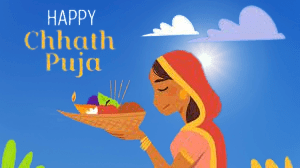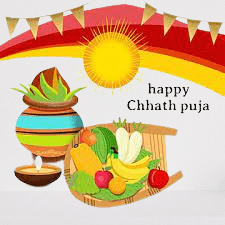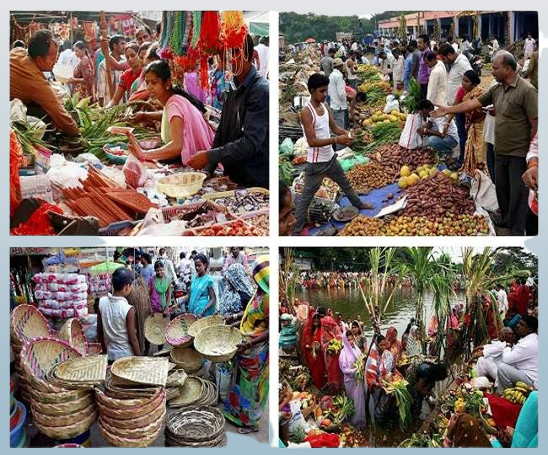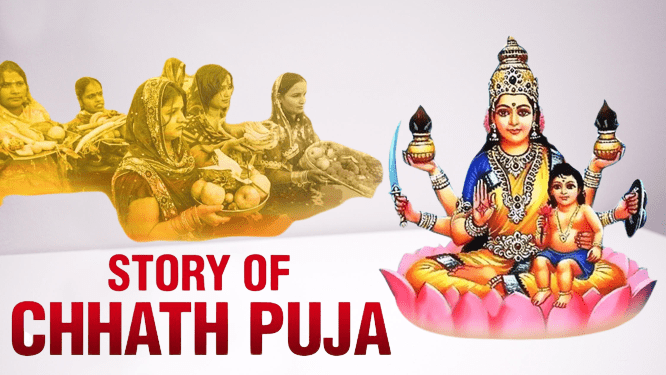Chhath Puja 2023: Chhath puja is also named as
- Chhaith
- Chhath Parva
- Chhath Puja
- Dala Chhath
- Dala Puja
- Surya Shashthi
Chhath is an Indian Hindu festival more specifically, the Indian states of Bihar, Uttar Pradesh, Madhya Pradesh, Jharkhand, West Bengal and Nepal. Prayers during Chhath puja are dedicated to the solar deity, Surya, to show gratitude and thankfulness for bestowing the bounties of life on earth and to request that certain wishes be granted.

Chhath Puja
During Chhath Puja, Chhathi Maiya, the sixth form of Devi Prakriti and Lord Surya’s sister is worshipped as the Goddess of the festival. It is celebrated six days after Deepavali, on the sixth day of the lunar month of Kartika (October–November) in the Hindu calendar Vikram Samvat. The rituals are observed over four days. They include holy bathing, fasting and abstaining from drinking water (vrata), standing in water, and offering prasad (prayer offerings) and arghya to the setting and rising sun.
Significance of Chhath Puja
Chhath puja is dedicated to the sun god Surya. The sun is visible to every being and is the basis of life of all creatures on earth. Along with the Sun God, Chhathi Maiya is also worshipped on this day. According to Vedic astrology, Chhathi Maiya (or Chhathi Mata) protects the children from diseases and problems and gives them long lives and good health.
Chhath Puja is a folk festival that lasts four days. It starts with Kartik Shukla Chaturthi and ends with Kartik Shukla Saptami. Chhath is celebrated twice in a year.

- Chaiti Chhath – It is observed in the Chaitra month of Vikram Samvat.
- Kartik Chhath – It is celebrated at a very large scale in the Kartika month of Vikram Samvat.
4 Days of Chhath Puja
Nahaay Khaay (Day 1)
This is the first day of Chhath Puja. The Parvaitin or devotees must take a holy bath, after which the entire house, its surroundings and pathways to the Ghat are thoroughly cleaned. The Parvaitin usually cooks Sattvik Lauka Bhaat (Bottle Gourd and Bengal Gram Lentil preparation with Arva Rice Bhaat). This preparation is served to the deity in the afternoon as Bhog. This initiates the Parv and is the last meal of the Parvaitin during Chhath Puja. The food is then eaten to protect the mind from thoughts of vengeance.

Rasiaav-Roti/Kharna/Lohanda (Day 2)
Kharna, also known as Rasiaav-Roti or Lohanda, is the second day of Chhath Puja. On this day, the devotees do not drink even a single drop of water as offer to worship. In the evening, they eat gur ke kheer (Kheer made up of jaggery), called Rasiaav, together with Roti.
Sanjh ka Arag (Day 3)
This day is spent preparing the prasad (offerings) at home, often consisting of a bamboo basket decorated with fruits, Thekua and rice laddus. On the eve of this day, the entire household accompany the devotee to a riverbank, pond, or other large body of water to make the Arghya offerings to the setting sun. The occasion can in many ways resemble a carnival. Besides the devotees and their friends and family, numerous participants and onlookers are all willing to help and receive the blessings of the worshipper.
At the time of arghya, Gangajal water is offered to Sun God and the Chhathi Maiya is worshipped with the prasad. After the worship of Sun God, Chhath songs are sung in the night and the Vrat katha is read.
After returning home the devotees perform the ritual of kosi bharai together with the other family members. They take 5 to 7 sugarcanes and tie them together to form a mandap and beneath the shade of that mandap, 12 to 24 Diya lamps are burnt and thekua and other seasonal fruits are offered. The same ritual is repeated the next morning between 3 am and 4 am, and afterward the devotees offer arghya or other offerings to the rising sun.
Bhor ka Aragh (Day 4)
Before sunrise on the last day of Chhath puja, the devotees have to go to the riverbank to offer an arghya to the rising sun. After this, the protection of the child and the peace and happiness of the entire family is sought from Chhatti Maiya. After worship, devotees drink water and eat a little prasad in order to break one’s fast. This is called Paran or Parana.
Rituals and Traditions
The main worshippers, called parvaitin, are usually women. However, many men also observe this festival as Chhath is not a gender-specific festival. The parvaitin pray for the well-being of their family, and for the prosperity of their children.

In some communities, once a family member starts performing Chhath Puja, they are duty-bound to perform it every year and to pass it on to the following generations. The festival is skipped only if there is a death in the family that year. If the person stops performing the ritual on any particular year, it stops permanently and one cannot resume it. In other communities, this is not mandatory.
The prasad offerings include Thekua, Khajuria, Tikri, Kasar (and fruits (mainly sugar canes, sweet lime, coconut, banana and many seasonal fruits) offered in small bamboo baskets. The food is strictly vegetarian and is cooked without salt, onions or garlic. Emphasis is put on maintaining the purity of the food.
Chhath Puja 2023 Dates
| Chhath Puja 2023: | |||
| Date | Day | Event | Hindi Tithi |
| 17th November 2023 | Friday | Nahay Khay | Chaturthi |
| 18th November 2023 | Saturday | Lohanda and Kharna | Panchami |
| 19th November 2023 | Sunday | Sandhya Arghya (Chhath) | Shashthi |
| 20th November 2023 | Monday | Usha Arghya, Parana Day | Saptami |
Dedicated to Lord Shiva, Chhath Puja is one of the religious festivals of India. This year the festival is going to be celebrated on 19th November 2023. During the four long-days of Chhath Puja, devotees worship Lord Surya.
For more articles please visit read4knowledge.